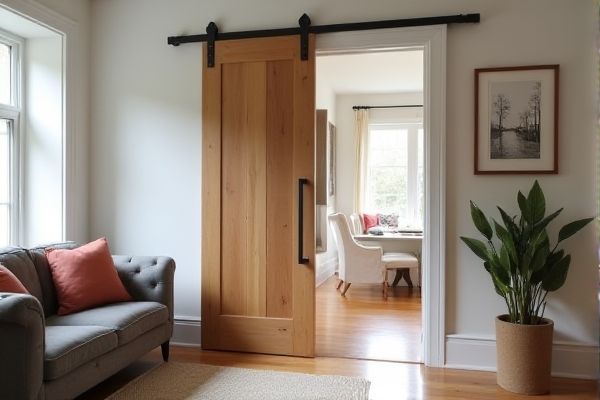
Pocket doors save space by sliding discreetly into the wall cavity, making them ideal for small rooms or tight areas. If you're curious about how barn doors compare in style, installation, and functionality, continue reading to discover which option suits Your needs best.
Table of Comparison
| Feature | Pocket Door | Barn Door |
|---|---|---|
| Installation | Built into wall cavity; requires wall modification | Mounted on exterior wall with visible track |
| Space Efficiency | Maximizes floor space; door disappears inside wall | Requires wall space beside opening to slide |
| Cost | Higher due to complex installation and materials | Lower to moderate; simpler installation |
| Maintenance | Harder access; potential for track or wall issues | Easy access to track and hardware for adjustments |
| Visual Style | Minimalist and concealed | Rustic, industrial, or decorative visible design |
| Wall Thickness Requirement | Must have adequate wall cavity depth | No wall thickness requirement |
| Sound Isolation | Better soundproofing when closed | Less sound isolation due to gaps and exposure |
| Common Uses | Bathrooms, closets, small rooms | Living rooms, kitchens, decorative interiors |
Introduction to Pocket and Barn Doors
Pocket doors slide into the wall cavity, saving floor space and offering a sleek, minimalist look ideal for small rooms or tight areas. Barn doors hang on an external track, providing a rustic, decorative element that becomes a statement piece while maintaining functionality. Both door types enhance room aesthetics and space efficiency but differ in installation complexity and visual impact.
Space Efficiency: Pocket vs Barn Doors
Pocket doors maximize space efficiency by sliding directly into the wall cavity, eliminating the need for floor clearance or wall space beside the doorway. Barn doors slide along the exterior wall, requiring additional clearance and wall space for installation but do not reduce visible wall area inside the room. For tight spaces or minimalist designs, pocket doors offer superior space-saving benefits compared to barn doors.
Design and Aesthetic Appeal
Pocket doors offer a sleek, space-saving design that seamlessly blends into walls, making them ideal for minimalist interiors and small spaces. Barn doors provide a rustic or industrial aesthetic with exposed hardware and sliding mechanisms, serving as a bold design element that enhances farmhouse, modern, or eclectic decor. Both door types create unique focal points, with pocket doors emphasizing subtlety and barn doors contributing distinctive character.
Installation Process: Ease and Complexity
Pocket doors require creating a recessed wall cavity, making their installation more complex and typically necessitating professional expertise, while barn doors mount directly onto existing walls, allowing easier and more flexible installation with minimal structural changes. Choosing between the two depends on your space constraints and willingness to undertake demolition or wall modifications for a pocket door versus the simpler bracket and track setup of a barn door. Your decision impacts time, cost, and the overall difficulty of the installation process.
Cost Comparison and Budget Considerations
Pocket doors typically cost between $500 and $1,500, including materials and installation, due to the need for wall modification and specialized hardware. Barn doors generally range from $300 to $1,200, offering a more budget-friendly option with easier installation and fewer structural changes. When considering budget constraints, barn doors are often preferred for their lower upfront costs and simpler installation process, while pocket doors may increase expenses due to labor and construction requirements.
Durability and Maintenance Needs
Pocket doors are often less durable due to their recessed installation, which can lead to issues with the sliding mechanism and frame over time, requiring occasional maintenance to prevent sticking or misalignment. Barn doors, constructed from solid wood or metal, typically offer greater durability and easier access for repairs or maintenance since they slide along an external track. Maintenance for barn doors mainly involves lubricating the hardware and tightening bolts, making them more convenient for long-term upkeep compared to pocket doors.
Noise Reduction and Privacy Factors
Pocket doors offer superior noise reduction and enhanced privacy by sliding into the wall cavity, effectively sealing the doorway and minimizing sound transmission between rooms. Barn doors, typically mounted on an exposed track, leave gaps around the frame that allow noise to pass through and provide less privacy. The solid wood construction of barn doors may offer some sound dampening, but pocket doors remain the optimal choice for minimizing noise and ensuring privacy.
Accessibility and User-Friendliness
Pocket doors offer enhanced accessibility by sliding seamlessly into the wall, allowing for unobstructed entry and more usable space, which benefits wheelchair users and individuals with mobility challenges. Barn doors, while visually appealing and easy to operate, require wall clearance to slide open, potentially limiting access in tighter spaces. Both door types improve user-friendliness compared to traditional swinging doors but differ in spatial requirements and ease of maneuvering.
Best Use Cases for Each Door Type
Pocket doors excel in areas with limited wall space, such as bathrooms and closets, where saving room is essential for maximizing interior layout and maintaining clean lines. Barn doors suit wide entryways, open-concept spaces, and rustic or industrial interior designs, offering stylish sliding options that add character without consuming floor space. Choosing between pocket and barn doors depends on spatial constraints, design preferences, and the desired balance between functionality and aesthetic appeal.
Final Verdict: Choosing Between Pocket and Barn Doors
Pocket doors save valuable floor space by sliding discreetly into the wall cavity, making them ideal for small rooms or tight areas. Barn doors add a rustic, decorative element while being easier to install and maintain but require wall space to slide open. Your choice depends on prioritizing space efficiency with pocket doors or aesthetic appeal and installation simplicity with barn doors.
 homyna.com
homyna.com